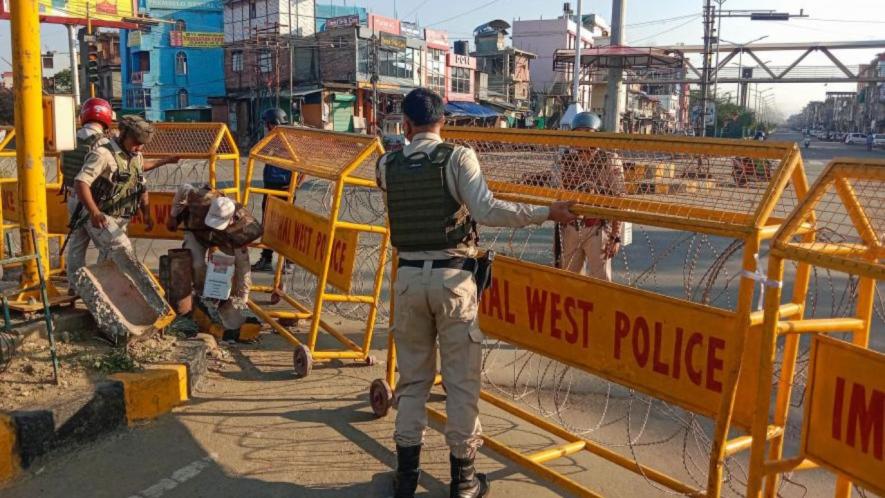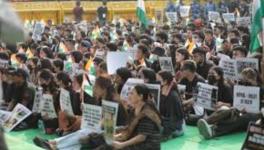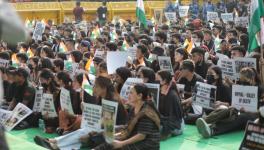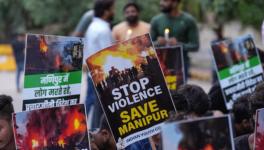Fiction of Governance in Manipur’s Hill Areas

Police personnel stand guard in a violence-hit area of Imphal town, Manipur, Sunday, May 28, 2023. Image Courtesy: PTI
Laws on tribal area governance in India, unlike other legislations, do not get unambiguously interpreted, nor are these implemented with finality. The Fifth Schedule of the Constitution says that state governments must frame laws to “prohibit or restrict the transfer of land by or among members of the Scheduled Tribes” in the Scheduled areas. Further, the Sixth Schedule provides for administering tribal areas in Assam, Meghalaya, Tripura and Mizoram. These regions are given legal protection, but governments have exploited loopholes that allowed land to be alienated from tribal populations, decreasing the corpus of tribal land and resulting in their forced migration.
Situation in Manipur
Manipur and Tripura are former princely states that were absorbed into India in October 1949. While Meghalaya, Manipur and Tripura were granted statehood on the same day, Manipur was not initially included in the Sixth Schedule. In Manipur, the Meitei people represent around 53% of the population, while various Naga ethnic groups comprise 24%, and the Kuki/Zomi tribes (also known as the Chin-Kuki-Mizo people) are 16% of the population, according to the Census Report 2011. The Naga and Kuki/Zomi ethnic groups occupy the hill regions of Manipur, which are 90% of its landmass. For a long time, the burning question in Manipur, especially in the hill areas, has been the poor quality of administration.
A proper assessment of Article 371C of the Indian Constitution is, therefore, warranted. This provision mandates not just setting up Hill Areas Committees (HACs) with all elected tribal MLAs represented in them, but also provides for modifications in the government’s rules of business to secure their proper functioning. Additionally, Article 371C(2) uses the term “shall”, which imposes a mandatory obligation on the state governor to send reports of the functioning of HACs to the President of India yearly or whenever necessary.
The first question then is for the government to answer: how many such reports from the Governor has the President received and what information do these contain?
District Councils After Hill Areas Committees
On December 26, 1971, the Government of India enacted the Manipur (Hill Areas) District Council Act to safeguard the hill areas and protect tribal groups. This Act enabled the creation of six Autonomous District Councils, or ADCs, in the hill areas of Manipur before their ultimate conversion to a full-fledged district. After attaining statehood in 1972, rules were framed by the Manipur Assembly to govern the established ADCs.
One must appreciate the constitutional prerogative to set up HACs and ADCs: These were meant to ensure good governance at the local level while keeping tribal sentiments and ethos in mind, and can be compared with the village panchayats given legal status under Part IX of the Constitution.
In any case, the more critical question arising in the context of the recent violence in Manipur is how effective these institutions have been. Unlike envisioned, the ADCs have been rendered ineffectual, compelling the HACs to adopt a resolution, as far back as July 18,1990, demanding the extension of the Sixth Schedule to the hill areas. Hill people also said at that time that no elections to ADCs would be held until this extension was granted. This demand has not been fulfilled till today.
In short, the ADCs have remained redundant. After over 21 years since inception, these were briefly revived when elections were held in 2010. But again, elections have been pending since May 31, 2020. Instead, the government symbolically reinstated the dissolved ADCs by retaining the chairpersons as “caretakers”. The second question, therefore, is: what is the state government’s justification for delaying these elections?
In 2021, the HAC pleaded for a special Assembly session to table the Manipur (Hill Areas) ADC Bill 2021, which sought to amend the 1971 District Councils Act. The state government ignored this request, laying the ground for an economic blockade imposed by the All Tribal Student’s Union Manipur (ATSUM)—the same student body that organised a peaceful protest rally on May 3.
On November 25, 2021, an ATSUM delegation and the State government signed an agreement in the presence of three ministers representing the hill areas as witnesses. It reassured ATSUM that there would be a discussion within five days in the Assembly on the draft ADC Bill.
Recall that in August 2015, the Manipur Assembly introduced three Bills in an “emergency session”—The Protection of Manipur People Bill, 2015; The Manipur Land Revenue and Land Reforms (Seventh Amendment) Bill, 2015, and The Manipur Shops and Establishments (Second Amendment) Bill, 2015 -- which were passed within two days. Agitations related to these enactments resulted in the death of nine tribals and a protest that lasted for over 600 days. It was only after the intervention of the Central government that these three laws were recalled. A third question then arises, should the state’s discretion on what matters it prioritises, remain unfettered?
If we now return to this year, on January 3, Manipur held its first Cabinet meeting at the Chief Minister’s secretariat in Imphal. After that, Information and Public Relations Minister Sapam Ranjan Singh told the media that urban and rural local body and ADC elections would be held in the first week of March and April. But no such elections were held. Keeping such an essential institution inoperative undeniably creates suspicion and leaves scope for its potential beneficiaries to make their own interpretations.
Thirst for Land
The ATSUM-led protest on May 3, in the Churachandpur district resulted in unprecedented mayhem. This was a direct outcome of the tactics that disregarded Schedule V and VI protection of tribals and their land holdings. Politics over land and reservation is not confined to Manipur, but the approach of the state government was bound to create resentment.
The “special order” issued last November, declaring huge swathes of tribal land as protected forest, reserved forest, wetlands etc., and the razing of “unauthorised churches” in Imphal after the Manipur High Court order (on April 11, these churches, in existence since 1974, were razed before sunrise) without following procedures established by law and overlooking the 90-day statutory period to appeal, were bound to antagonise the tribals.
On the 27th the very next month, a single bench of the Manipur High Court, in Mutum Churamani Meetei vs The State of Manipur and others, directed the state government to submit a recommendation regarding the inclusion of the Meitei community in the Scheduled Tribe category within four weeks.
The Manipur Tribal Forum Delhi appealed against this order in the Supreme Court (and filed a Writ Petition under Article 32 for the safety of displaced persons and setting up a Special Investigation Team). The Chief Justice of India orally remarked, citing State of Maharashtra vs Milind (2000), that the High Court did not have the authority to pass the April 11 order. At the second hearing on May 9, the apex court critically observed that the extension of the High Court’s earlier four weeks to one year is also not within the jurisdiction of the judiciary. It pointed out that inclusion or exclusion into the ST list was purely on the recommendation of the President of India based on Article 342(1) of the Constitution.
Citing the need for “national integration” in 1965, the Lokur Committee Report recommended five identifiers for recognition as ST—primitiveness, distinctiveness, isolation, inhibitions and backwardness. If a community not seen or known to fit any of these identifiers for inclusion in the ST category, raises the demand, it is bound to fuel misunderstanding, political one-upmanship and even conflict. Therefore, as long as the Manipur High Court order stands, it will only fuel the notion that tribal discontent is “meaningless” in Manipur. This will add more fuel to the anger over the practically non-existent ADCs.
Any claim of a non-tribal that they have (or must have) the right to purchase land in Schedule VI areas, amounts to disregarding the constitutional scheme. Suppose a community’s claims to tribal status appear valid, in that case, they must be pursued based on proper procedures, in which the first step is to ascertain the validity of the claim and then to amend the Constitution based on the findings. Recall also that in Samatha vs State of Andhra Pradesh and Others (1997), delivered in the context of Andhra Pradesh (Scheduled Areas) Land Transfer Regulation 1959, the Supreme Court held that any land transfer to a non-tribal was prohibited.
Finding the Right Path
It is time for finding lasting solutions to address the conditions and demands of the tribal community. They seek to be governed effectively by constitutional institutions, based on the principles of equality and fairness. There is no justification for depriving them of governance under their customary laws that are recognised and well-established in our federal and pluralistic legal system. In the world’s largest democracy, finding the right path should not be a tough call if the rule of law is the guiding force and the judiciary a faithful guardian of the rights of all citizens.
The author teaches at the Faculty of Law, University of Delhi. The views are personal.
Get the latest reports & analysis with people's perspective on Protests, movements & deep analytical videos, discussions of the current affairs in your Telegram app. Subscribe to NewsClick's Telegram channel & get Real-Time updates on stories, as they get published on our website.























